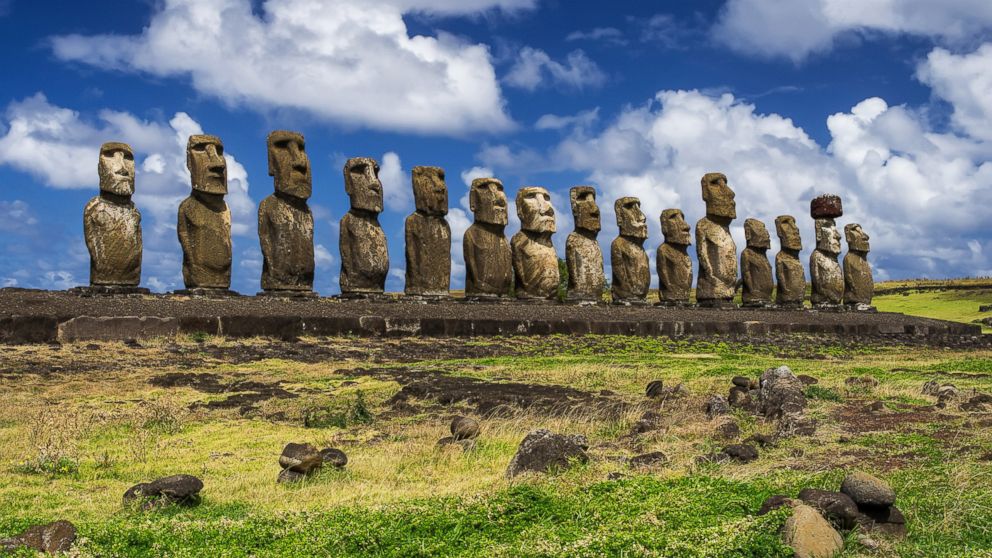Did Climate Change Condemn Easter Islanders?
New evidence suggests climate curtailed farming.

— -- The mysteries of the most isolated island in the world, Rapa Nui, commonly known as Easter Island, have baffled anthropologists and other scientists for generations, and one question about the curious inhabitants who erected those great, strange heads is what happened to the people who made them.
The island is best known for 887 monumental rock statues, weighing up to 82 tons and mysteriously moved over considerable distances by ancient people who had no beasts of burden, but that's only part of the story.
Scientists fiercely debate over how the early settlers got there, around 1200 A.D., whether they traveled east from the islands of Southeast Asia or west from South America in nothing more than canoes or crude catamarans, a staggering distance of around 2,000 miles.
The 63-square-mile island was once the home of a booming population of about 15,000, according to some estimates, but that number dwindled to about 2,000-3,000 around the time a few Europeans arrived on Easter Sunday, 1722. A century and a half later, when the number of Europeans was considerably greater, the population of islanders was down to 111.
Did Europeans, carrying diseases for which the islanders had no immunity, cause that precipitous decline? Many experts have said yes over the years, but a new international study offers evidence that the Europeans have been getting a bad rap.
The decline, according to this research, began before the first Europeans arrived and peaked just before they got there. The research doesn't prove the new arrivals didn't contribute to the decline, but if this is correct they did not initiate it.
The study, published in the Proceedings of the National Academy of Sciences, is based on a relatively new technique for dating artifacts that cannot be dated by other methods, like radio carbon ratios.
The newer method uses obsidian, a natural volcanic glass that is so homogeneous it can easily be split into razor-sharp instruments for many uses, including war and crop cultivation.
Obsidian hydration dating, as the process is called, proves the Europeans were not the primary culprit, according to the study by scientists from the Virginia Commonwealth University in Richmond, Stanford University, the University of Auckland in New Zealand, and University of California branches in Santa Barbara and Davis.
When it is formed during volcanic activities, obsidian contains a small amount of water, usually around 1 percent. But once it is exposed to the atmosphere, it absorbs moisture from the air at a fairly predictable rate.
The difference between those two numbers tells when the tool, or projectile point, was first crafted by "flint knapping" -- hitting the material with a harder rock to split it along predictable lines.
That process produces tools and weapons that are so effective that obsidian artifacts can be found at archaeological sites all over the planet. The objects recovered on the island and used for this study, however, were found to have been used for agricultural purposes, not warfare.
The researchers focused on three areas on the island that were vital for growing crops to feed the locals, known as the Rapanui. One area has relatively rich soil, but low rainfall. Another has poor soil, but lots of rain. And the third has good soil and moderate rain.
Rainfall data from 1958-1997, according to the study, "shows considerable year-to-year variation, with droughts occurring."
By then the island had been changed dramatically from the way it was when the first settlers landed. The hills had been deforested, and population growth had led to conflict, even between families, over dwindling resources.
Some of the forts were located on very inhospitable mountain ridges that were cold, windy, unsuitable for agriculture and far from water. So competition for what was left would have been fierce.
It probably made them long for their earlier homes, wherever they may have been, which scholars continue to debate.
Did they use the westerly winds to travel from the Philippines or some other islands, or did they fight the wind to paddle from South America to Rapa Nui? They farmed sweet potatoes, which must have come from Chile, and they had chickens that some think must also have come from Chile. So which way did they come?
Forget about the chickens. Scientists at the University of Adelaide announced last March that DNA analysis of chicken bones found on Easter Island matched the genome of chickens in Polynesia, not South America.
But last October, two different scientific teams reported evidence that the Rapanui not only paddled to South America, they may have traveled back and forth, a distance of nearly 2,500 miles. But they didn't originate in South America, according to studies published in Current Biology.
That conclusion was based on genomic analysis of 27 of the 500 or so residents today of Rapa Nui. They were definitely of Polynesian descent since there was "no detectable Native American component at all" in the genomes.
But what about those sweet potatoes? Either South Americans took them to Rapa Nui hundreds of years ago, a difficult task indeed, just finding the tiny speck in the middle of the ocean. Or the Rapanui traveled back and forth, even though each trip would have taken as long two months.
It seems more likely that the Rapanui traveled to South America rather than the other way around because they would have had a bigger target.
Whatever the answer, it's an amazing story.



